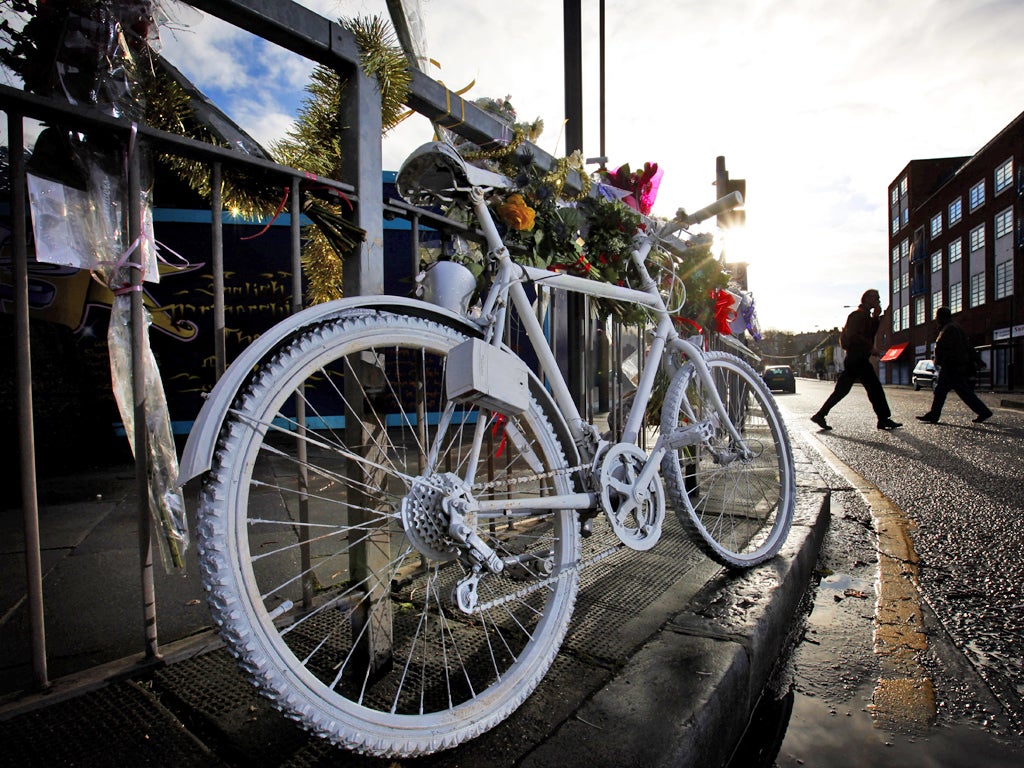The 'ghost bike' revolt: Families demand action on cyclist deaths
Minister accused of failure to act as protest against rise in fatalities gathers momentum

The number of cyclists killed and seriously injured on Britain's roads has risen by 8 per cent compared to last year despite improvements in injury rates for all other road users.
Families of the cyclists killed in crashes accused politicians of "not listening" as they prepared to join cyclists in central London on Sunday as part of a campaign to improve road safety.
Newspapers, now including The Times as well as The Independent and the Evening Standard, have added weight to demands for legislation that would require lorries to fit safety devices, and improve the layout of increasingly crowded roads. Kate Cairns, whose sister Eilidh was killed by a lorry driver in London in 2009, accused politicians of "complacency". She said: "There is an implicit idea that there are accidents, that they are unavoidable. But these are not accidents."
Roads Minister, Mike Penning, faced criticism over comments he made to the House of Commons Transport Committee, suggesting that cyclists running red lights were responsible for deaths and injuries. He said last week: "It would help save a lot of cyclists' lives and stop a lot of serious injuries if so many of you didn't go through a red light... Now that's not saying that we should make them all criminals and all pariahs and there are motorcycles that go through but it is so bloody dangerous."
Cynthia Barlow's 26-year-old daughter, Alex McVitty, was killed when she was hit by a cement lorry in 2000. Her mother said the Government should lead on cycle safety. "The problem is that our concerns and recommendations are not being acted on," she said.
Ms Barlow, who is chair of the RoadPeace safety campaign group, said most responsibility for safety on the roads should rest with the "person who poses the most risk to the rest of the road users. If people are going to put their staff out there on the roads, then they need to make sure they are properly equipped."
Responding to Mr Penning's comments, a RoadPeace spokesman said: "Cyclists are not being killed running red lights, it is when they are moving away from a red light with a lorry. It is disappointing to hear it from the minister who is supposed to be in charge of fixing the problem."
Ms Cairns, along with RoadPeace, is campaigning for laws requiring all HGVs to be fitted with sensors to eliminate blind spots. They plan to meet on Sunday – the anniversary of Eilidh Cairns' death – to launch a website called SeeMeSaveMe as part of a campaign to make the sensors a legal requirement.
A Department for Transport spokesman said: "We are committed to improving safety for cyclists and encouraging cycling as a healthy and enjoyable way of getting around."
Safe cycling: A guide
Avoid lorries
Never wait between the kerb and a lorry at a junction. If the lorry turns left, the driver may not see you. Stay well behind or, preferably, in front, where you can be seen.
Stay clear of the kerb
The kerb is not your friend. Ride clear of it so that drivers steer around you. Hugging the pavement invites them to try and scrape past.
Show your face
Looking at drivers at junctions helps them to view you as a fellow road user they would rather not run over. Do the same to vehicles on your tail.
Use your neck
Learn how to look over your shoulder without wobbling and do so regularly – particularly before making a manoeuvre, when you should also stick out an arm.
Obey the code
Some may argue that it is safer, say, to jump a red light than wait in a lorry's shadow but egregious violations endanger you and harm the image of cyclists.
Overtake buses
If you're approaching a bus at a stop, look over your shoulder, and move to overtake. If you can't, wait behind the bus. Never undertake.
Be bright
It's more important to show your face and position yourself well, but bright clothing, strong lights and reflectors will help you get noticed.
Plan your route
It stands to reason that you're probably more vulnerable in three lanes of traffic doing 40mph than on a residential side street.
Find a friend
If you're a new or lapsed cyclist, venture out with a more experienced friend. Keep a good distance behind and watch. Then let them follow you and take their advice.
Simon Usborne
Join our commenting forum
Join thought-provoking conversations, follow other Independent readers and see their replies
Comments